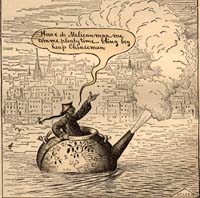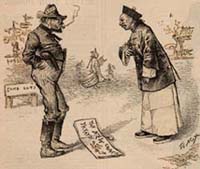


|
The California gold rush of the late 1840's sparked a mass migration to
the West.
Rumors that this was a place to "get rich quick" inspired many in
the poverty-stricken districts in and around Hsin-ning, China to head to
America and try their luck in the mines.
As Kil Young Zo points out in his doctoral dissertation on Chinese immigration in the late nineteenth century, the majority of Chinese residents on the West Coast were from this rural area in southern China. Zo attributes three causes for the great number of immigrants arriving from Hsin-ning over the next three decades: |
As work in the mines dried up with the prospects of gold, many Chinese immigrants moved to the cities or worked for the Central Pacific Railroad. Of the 4,000 men working for the CPR in 1865, only 1,000 were white. By 1869, there were still around 1,000 white employees but the number of Chinese employed had increased to 9,000.
When the railroad was completed, all 10,000 men were released and forced to find new jobs. This action, along with other less drastic fluctuations in the California economy generated a good deal of antagonism between workers of different races. As early as 1852, an anti-Chinese sentiment began appearing in political campaigns.
| Although the Chinese usually had no problem finding work in the new land, it was impossible for them to receive fair treatment. The United States government did not consider these immigrants to be legal citizens and so, it seems the only legitimate right the Chinese had in America was the right to work. |

|
"During the whole of this period they were excluded from the city hospital in San Francisco, and the only ones to which they were ever freely admitted were the insane asylums and the pest-house."
One outgrowth (or reason) for such hostile treatment was due the fact that the majority of Chinese maintained their traditional customs and way of dress while in the United States. Later in the 1909 study, it states:
"If the Chinese had worn American clothes and been able to vote,. . .they might have suffered scarcely [no] more persecution. . .than the normal amount arising from color prejudice. But being constantly in the public eye by reason of their peculiar appearance and lacking political power for their own protection, they were the natural victims of ignorant men who were both malicious and cowardly, and of the politicians dependent upon the Labor vote."
